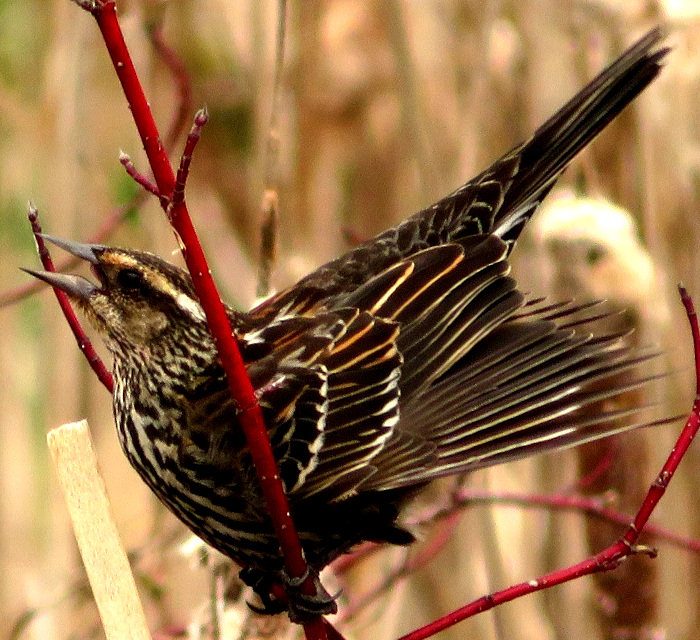 Precopulation display of female Red-winged Blackbird, Agelaius phoeniceus; image © Laura Maskell, Ontario, Canada
Precopulation display of female Red-winged Blackbird, Agelaius phoeniceus; image © Laura Maskell, Ontario, CanadaFor sharp observers, nothing is more fun that learning to interpret messages birds send one another. Birds communicate not only with sound, but also with their bodies. Certain movements and positions, often coordinated with sounds, occur again and again, and are called displays. For example, the female Red-winged Blackbird shown above presents her "precopulation display," described in detail in Robert Nero's classic paper A Behavior Study of the Red-winged Blackbird. Her message to a male bird is, "I'm ready... "
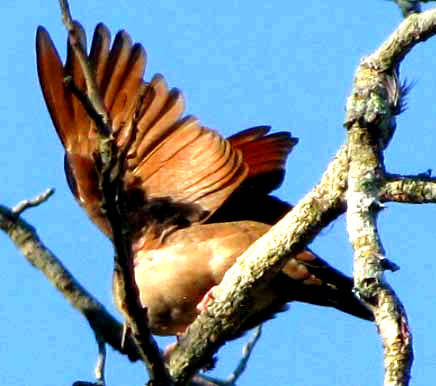
At the left, a ruddy Ground-dove, Columbina talpacoti, being attacked by two or three flycatchers, opens his beak and raises his wings, not only displaying his willingness to bite, but also making himself look larger. This species normally looks rather mousy and innocuous, so when the wings are suddenly spread revealing the contrasting patches of rusty-red and black atop them, that might distract or even discourage an attacker. Most often when we think of bird displays, we visualize those dealing with courtship, as when the male Peacock fans out his tail feathers, communicating to the female that he's a robust, healthy male. However, this Ruddy Ground-dove reminds us that the concept of animal displays is more general. The communication doesn't have to relate to courtship, and even can take place between different species.
An animal display is a set of ritualized behaviors which communicates to other animals with reference to specific stimuli, such as the urge to mate, and the need to defend oneself.
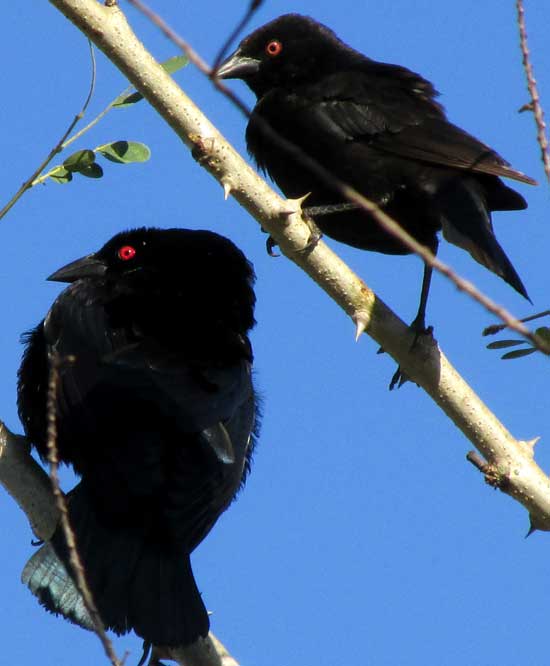
At the right, a male Bronzed Cowbird, Molothrus aeneus, displays before a female. In a freely downloadable 1995 paper by Ethan Clotfelter, we read that "the male erects the ruff feathers around his neck, raises his partially opened wings to head level, and turns his bill slightly downward." It's further said that while maintaining this posture, he rocks from side to side and slowly circles the female. It's quite a display, and from an anthropomorphic perspective, especially with those devilishly red eyes, the whole thing looks a bit raunchy.
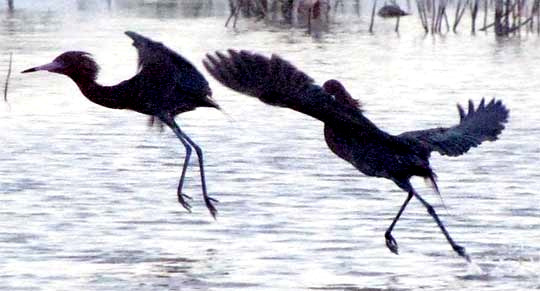
At the left, two Reddish Egrets, Egretta rufescens, in a coastal saltmarsh at dusk perform an amazing courtship display with bill-clapping, graceful jumping and whirling about, diving and feinting, like Japanese martial arts masters in fantastical movies mixing real and unreal in a most beautiful way. Some displays, see, are complex, displaying not only form and color, but also the very stuff one is made of.
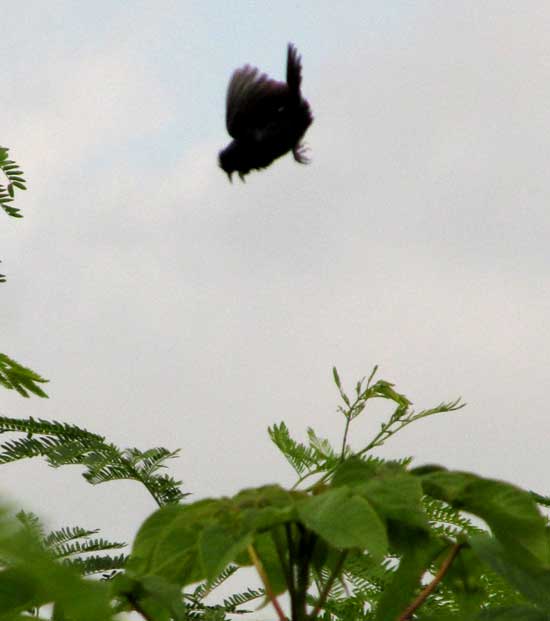
In general, in the world's tropics bird diversity is at its greatest, as well as the diversity of bird behavior. One of the most surprising behavioral displays seen in the tropics is shown by the male Blue-black Grassquit, Volatinia jacarina, at the right, who during the nesting season spends long hours calling, with occasional "jumping times." Jumping sessions last maybe 20-30 minutes, and during them individual jumps may take place every 15 seconds or so. Rest breaks between sessions are taken of various lengths. The bird perches on a conspicuous twig or fence, suddenly flies straight up for a foot or two, often while issuing a buzzy wheeze-call, then just as suddenly dives beak-down back to the same perch or maybe nearby. The whole process must be exhausting, and it's been shown that the display not only defends the nesting site from other Blue-black Grassquites, but also attracts predators, with predation being the main cause of breeding failure. It's hard to know exactly how this display could evolve, and be adaptive, but Nature seems to have it figured out; Blue-black Grassquits are common and widespread in open to mostly open, grassy, often-disturbed places from southern Mexico to central South America.
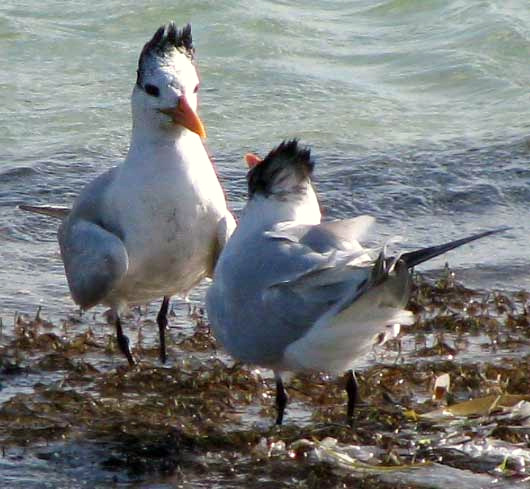
At the left, Royal Terns, Thalasseus maximus appear to be displaying to one another during a confrontation. However, these birds are overwintering during late December, when courtship behavior and territorial disputes are unlikely. Though it's hard to say whether these are juveniles, juvenile Royal Terns are famous for "acting out" in front of their parents. Sometimes the parents intervene but other times they just stand calmly and let the tantrum pass, so this picture teaches that sometimes displays are hard to interpret, and no amount of looking for explanations in research papers on the Internet clarifies matters. Notice how one bird's crest swoops forward, while the other's swoops backwards. Is this significant? There's still very much to learn about the displays of every bird species.
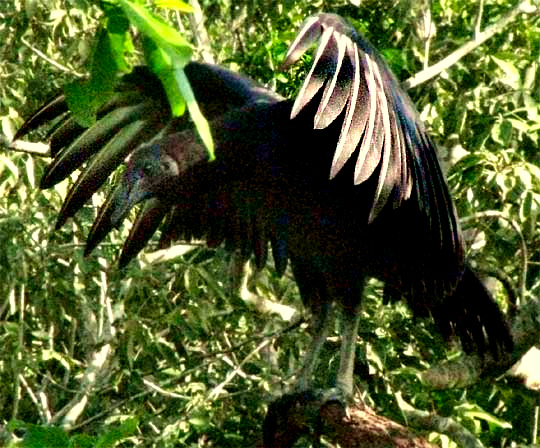
Finally, sometimes birds are seen doing something very strange, such as the Black Vulture, Coragyps atratus, at the right. That bird isn't displaying, though. He's simply drying his feathers in the morning sunlight, after a night of heavy rain.
If you're interested in learning more about displays and bird behavior in general, check out the books shown below. Also, you might enjoy our short story about one year in the life of a House Sparrow, in which many of that bird's behaviors are described.